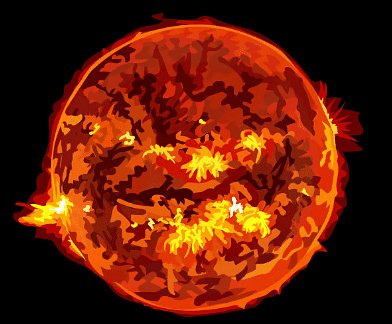The Solar System & The Formation of the Sun | Physics for Grade 10 PDF Download
| Table of contents |

|
| Objects in The Solar System |

|
| Our Place in Space |

|
| The Formation of the Sun |

|
| Equilibrium in Stars |

|
Objects in The Solar System
- The Sun lies at the centre of the Solar System
- The Sun is a star which makes up over 99% of the mass of the solar system
- There are 8 planets and an unknown number of dwarf planets which orbit the Sun
- The gravitational field around planets is strong enough to have pulled in all nearby objects with the exception of natural satellites
- The gravitational field around a dwarf planet is not strong enough to have pulled in nearby objects
- There are 4 rocky planets: Mercury, Venus, Earth and Mars
- There are 4 gas planets: Jupiter, Saturn, Uranus and Neptune
- Some planets have moons which orbit them
- Moons are an example of natural satellites
- Artificial satellites are man-made and can orbit any object in space
- The International Space Station (ISS) orbits the Earth and is an example of an artificial satellite
- Asteroids and comets also orbit the sun
- An asteroid is a small rocky object which orbits the Sun
- The asteroid belt lies between Mars and Jupiter
- Comets are made of dust and ice and orbit the Sun in a different orbit to those of planets
- The ice melts when the comet approaches the Sun and forms the comet’s tail
 The objects in our solar system
The objects in our solar system
Exam Tip
You need to know the order of the 8 planets in the solar system. The following mnemonic gives the first letter of each of the planets to help you recall them:
My Very Excellent Mother Just Served Us Noodles
Mercury, Venus, Earth, Mars, Jupiter, Saturn, Uranus, Neptune
Before Pluto was reclassified as a dwarf planet in 2006, 'my very excellent mother' used to 'serve us' 'Nine Pizzas' and you can still use that one to remember the 'old' solar system!
Our Place in Space
- Our solar system is just one small part of the Milky Way galaxy
- There are billions of stars in the Milky Way galaxy
- Some of these stars also have planets which orbit them
- The Universe is made up of many different galaxies
 Our solar system is just one out of potentially billions in our galactic neighbourhood, the Milky Way. There are estimated to be more than 100 billion galaxies in the entire universe
Our solar system is just one out of potentially billions in our galactic neighbourhood, the Milky Way. There are estimated to be more than 100 billion galaxies in the entire universe
The Formation of the Sun
- The Sun is formed from massive clouds of dust and gas in space
- A cloud of dust and gas in space is called a nebula
 A nebula is a cloud of gas and dust in space (Image courtesy of NASA)
A nebula is a cloud of gas and dust in space (Image courtesy of NASA)
- Gravity pulled this cloud together into a giant ball
 The nebula collapses due to gravity and begins to rotate (Image courtesy of NASA)
The nebula collapses due to gravity and begins to rotate (Image courtesy of NASA)
- As the nebula collapsed the centre of this ball got very dense and hot and began to rotate
- Eventually nuclear fusion was able to begin and a dense protostar was formed – our Sun
 Our Sun (Image courtesy of NASA)
Our Sun (Image courtesy of NASA)
Equilibrium in Stars
- Stars are held together by a delicate balance of inwards and outwards forces
- One of these forces is the force of gravity
- This is an attractive force which pulls the outer layers inwards
- The other force is the force of pressure
- This is an outward force which is exerted from the expanding hot gases inside the star
- When the inward pull of gravity and the outward pressure acting on the star are equal the star will be in equilibrium
 Forces acting within a star. The centre red circle represents the star's core and the orange circle represents the stars outer layers
Forces acting within a star. The centre red circle represents the star's core and the orange circle represents the stars outer layers
- If the temperature of a star increases, the outward pressure will also increase
- This will cause the star to expand
- If the temperature drops (because, perhaps, the rate of fusion has slowed) the outward pressure will also decrease
- This will cause the star to contract
|
124 videos|149 docs|37 tests
|

|
Explore Courses for Grade 10 exam
|

|

















